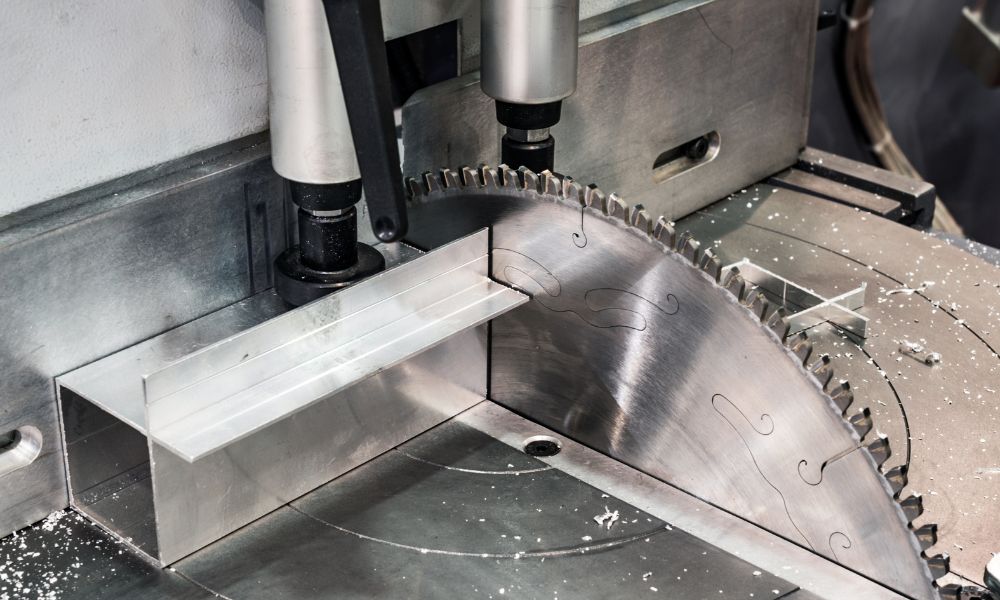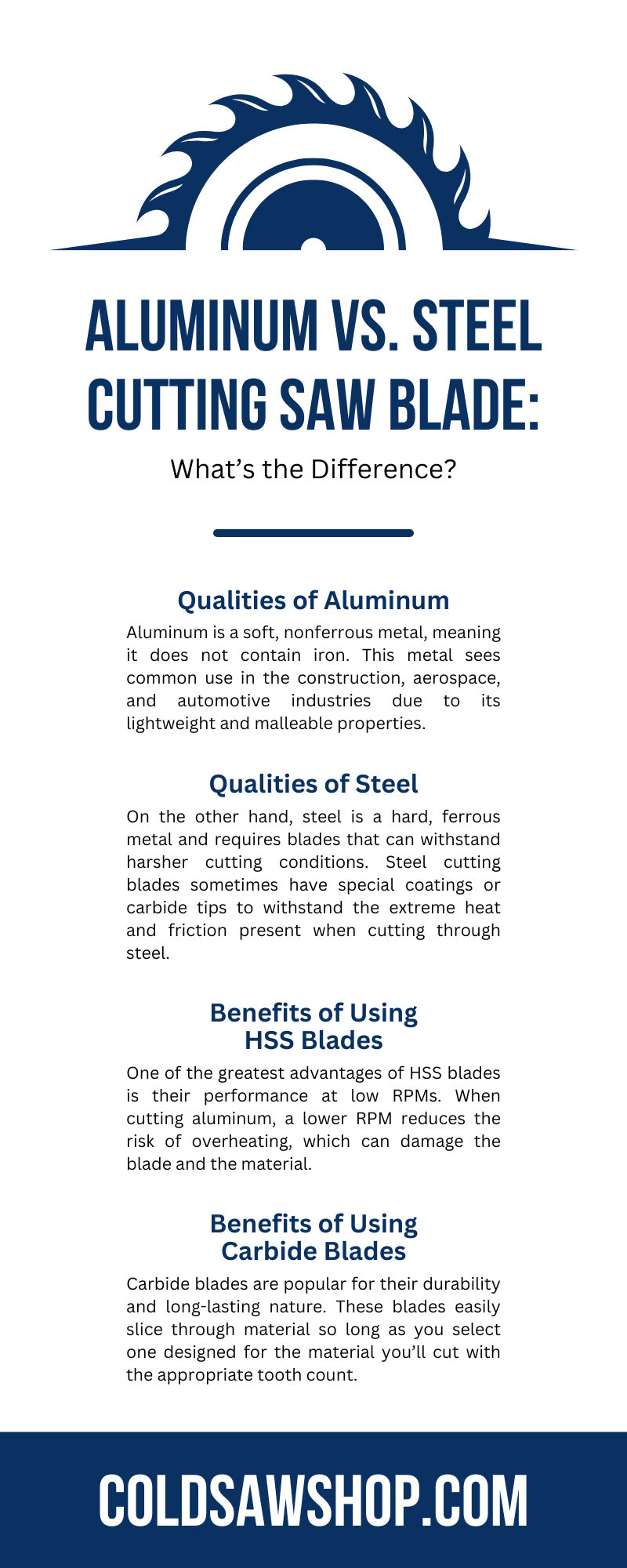
Aluminum vs. Steel Cutting Saw Blade: What’s the Difference?
Having the right saw blade can make all the difference when cutting materials like aluminum and steel. Think of saw blades as a family tree that branches off into different options. Specifically, focus on aluminum and steel blades. Both break down into even smaller categories, and the more you understand each option, the easier it is to determine which option will best fulfill your needs.
This guide will explain the difference between aluminum and steel cutting saw blades.
Primary Differences Between Aluminum and Steel
Understanding these differences can significantly impact the efficiency and quality of your work. Here are the main differences between aluminum and steel cutting saw blades:
Qualities of Aluminum
Aluminum is a soft, nonferrous metal, meaning it does not contain iron. This metal sees common use in the construction, aerospace, and automotive industries due to its lightweight and malleable properties. Blades crafted to cut aluminum can handle this soft metal without damaging or warping the material.
Qualities of Steel
On the other hand, steel is a hard, ferrous metal and requires blades that can withstand harsher cutting conditions. Steel cutting blades sometimes have special coatings or carbide tips to withstand the extreme heat and friction present when cutting through steel.
Aluminum vs. Steel Cutting Blades
The main difference between saw blades for aluminum and steel cutting depends on the task you have planned. Professionals often use specific high-speed steel (HSS) or carbide-tipped blades for steel or aluminum cuts. Cermet blades are another option for steel cutting projects that we’ll cover.
High-Speed Steel (HSS) Blades
When cutting aluminum with a low-RPM saw, HSS blades are the only choice because they use a lower RPM than carbide-tipped blades. RPM stands for revolutions per minute. It measures the speed at which the blade spins when cutting through material.
HSS blades are the most popular option for cutting steel due to their high quality. Keep in mind that an HSS blade designed to cut mild steel may not be able to cut stainless or alloyed steel due to the difference in hardness.
Often, professionals use HSS blades for projects like cutting aluminum downspouts. They're also ideal for cutting steel studs, bars, and sheets.
Benefits of Using HSS Blades
One of the greatest advantages of HSS blades is their performance at low RPMs. When cutting aluminum, a lower RPM reduces the risk of overheating, which can damage the blade and the material. This also ensures that the blade remains sharp longer, which keeps your work productive.
Carbide-Tipped Blades
Due to their high durability, carbide blades are the top pick for tougher materials like steel. However, carbide blades also work well on softer metals like aluminum and are the ideal option for this nonferrous metal.
Benefits of Using Carbide Blades
Carbide blades are popular for their durability and long-lasting nature. These blades easily slice through material so long as you select one designed for the material you’ll cut with the appropriate tooth count.
Another Steel Cutting Blade Type: Cermet Saw Blades
Cermet blades have a high heat resistance and hardness, making them ideal for cutting through tough steel material. They are also less prone to chipping or breaking, making them a reliable and long-lasting option for steel-cutting projects.
A cermet blade can cut steel at high speeds, which is ideal for boosting productivity during large-scale projects. Moreover, they have a higher productivity and performance rate than HSS steel cutting blades.
How To Choose the Right Saw Blade
Using the wrong type of blade for your project can lead to poor-quality cuts, excessive wear and tear on the blade, and potential safety hazards. For instance, using a cermet saw blade on aluminum can damage the material and result in rough, uneven cuts. It’s always best to take your time as you shop and note key information about your metal cutting project.
To determine which type of blade you need, review key factors, including cutting material, tooth count, tool specifications, and blade quality. This will ensure you make the best purchase.
Consider the Cutting Material
When deciding on a cutting blade, note whether you’ll cut a ferrous or nonferrous metal. While HSS blades can work on other metals, cermet blades only work for cutting steel. Trying to use a cermet blade on nonferrous metals can ruin the material.
Evaluate Tooth Count
The blade’s tooth count is important whether you cut steel or aluminum. This can vary depending on material, application, and size of the blade. Never assume that more teeth mean faster or better cuts, as this isn’t always the case. If you don’t know the ideal tooth count based on your needs, reach out to the company you want to buy your aluminum or steel cutting blade from.
Know Your Tool’s Specifications
Noting your saw's capabilities helps you determine which blade you should purchase. Some saws can only use HSS or carbide-tipped blades, while others are interchangeable. Always review your tool manual before purchasing a blade.
When reviewing tool specifications, also inspect the blade’s product details. Often, manufacturers create options like cold saw blades for steel separate from those for softer metals. Blades labeled “for nonferrous” cut soft metals like aluminum or copper and don’t have the strength to slice through steel.
Your Saw’s RPM
If your saw has a low RPM and you need to cut steel or aluminum, an HSS blade is the only choice since it can handle lower RPM operations.
Buy Quality Blades
Investing in high-quality saw blades can make all the difference in achieving efficient and precise cuts. Whether you're working with aluminum or steel, choose a blade designed specifically for the material and ensure it is of good quality.
Pro Tip
Keep your blade maintained by using lubricants when applicable. Likewise, ensure you bring your blade to a professional for sharpening services as needed to preserve its sharpness.
Cold Saw Shop
Don't compromise on the quality of your cuts—invest in the right saw blade today. At Cold Saw Shop, you can buy top-quality HSS, carbide, and cermet blades for cutting aluminum and steel. With our wide range of options and expert guidance, you can find the perfect blade to meet your cutting needs.
Our team is readily available if you need assistance choosing the right blade for your project. Invest in quality saw blades and see the difference in your cutting efficiency and results.
